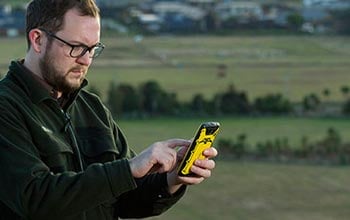Get Your Water System's Spring Cleaning List Done Faster Using Trimble GIS
- Home
- Team EJP Blog
- Get Your Water System's Spring Cleaning List Done Faster Using Trimble GIS
- May 18, 2018 12:41:50 PM
- Everett J. Prescott
Spring system maintenance. It's one of those tasks that people in the water utility industry both love and hate. Lovely spring days and outdoor weather are awesome to work in after winter's cold months, but knocking out long task lists and making out your crew's to do list means long hours and a lot of questions or potential for errors in your logs in the end. Even worse is finding the hydrants, valves and other fixtures that you need to test. Fortunately, there's an easier way to get it done by adding Trimble GIS software to your toolkit.

If you've spent significant time in water utility work, you've seen it - maintenance tasks that take forever because the crew can't find the hydrant or takes poor notes. After a long winter, hydrants and valves may be in need of maintenance, repair or replacement due to freezing damage, soil heaving or similar cold-weather issues. Hydrants may need weeds trimmed, caps greased and valves exercised to ensure their easy use in emergencies. But how do you make the process go more easily? Trimble GIS software is the right answer for many water utilities.
When you're using a GIS system, you can more quickly and easily find hydrants, valves, meters and other essential components of your water utility's system. Unlike markers that can be damaged, moved or removed, GIS systems are independent of any local changes to your system's fixtures. Your crew simply needs to pull up the next item of the list, use the GIS software to locate it, make the necessary maintenance and repair tasks, then record the information in the software system, helping you avoid hours of interpreting bad handwriting.

But exactly how does Trimble GIS software work to help with these issues? By using satellites to locate the fixture, your crew can simply follow on-screen prompts to the exact location, giving them a much smaller area to search. Computerized records allow them to see not only what needs to be done, but can also include information such as the date of manufacture for the hydrant, past issues and similar data, making it much easier to determine when a specific hydrant is having issues that may warrant further repairs or replacement. The records can also include specific location information, such as whether the dog behind the chain link fence in the front yard will try to bite someone if given a chance.
Trimble GIS systems also make it easy to determine which hydrants will be taken offline for field repairs of a particular main, making it easier to provide the fire department with a list of potential problem areas while the repairs are underway. You can more easily determine your asset inventory by simply pulling up a computer report rather than wading through dozens of files. It's also easier to spot trends with particular batches or models of hydrants.
By adding Trimble GIS software to your routine maintenance tasks, you can get them done more quickly, neatly and legibly than simply sending your crew out to track down every fixture that needs work. Team EJP is here to help. Please feel free to contact our experienced associates today for more details, with any questions or to get started on the right system for your situation.








